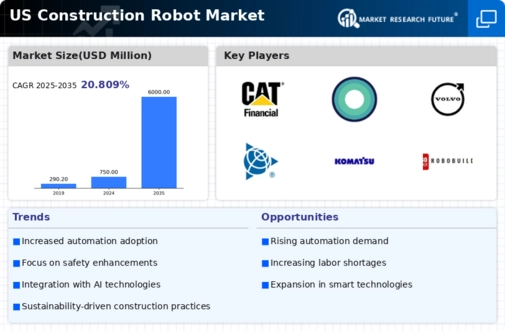Increased Focus on Sustainability
The construction industry is increasingly prioritizing sustainability, which is influencing the construction robot market. Robots can contribute to more sustainable practices by optimizing resource use and reducing waste. For instance, robotic systems can precisely measure and cut materials, minimizing excess and ensuring efficient use of resources. Additionally, the ability of robots to work in hazardous environments reduces the risk of accidents, promoting safer and more sustainable construction practices. As environmental regulations become stricter and public awareness of sustainability grows, the construction robot market is expected to expand, driven by the demand for eco-friendly construction solutions.
Government Initiatives and Funding
Government initiatives aimed at promoting innovation in the construction sector are playing a crucial role in the growth of the construction robot market. Various federal and state programs are providing funding and incentives for the adoption of advanced technologies, including robotics. These initiatives are designed to enhance productivity, safety, and sustainability within the industry. For example, the US Department of Labor has launched programs to support workforce development in construction technology. As these government efforts continue to evolve, they are likely to stimulate investment in the construction robot market, encouraging companies to integrate robotic solutions into their operations.
Technological Advancements in Robotics
Currently, there is a surge in the construction robot market due to rapid technological advancements in robotics. Innovations in artificial intelligence (AI), machine learning, and sensor technologies are enhancing the capabilities of construction robots. These advancements allow for improved precision, efficiency, and safety on construction sites. For instance, robots equipped with AI can analyze data in real-time, enabling them to adapt to changing conditions and optimize workflows. The market is projected to grow at a CAGR of approximately 25% from 2025 to 2030, driven by these technological improvements. As construction companies increasingly adopt these advanced robotic solutions, the construction robot market is likely to expand significantly, reshaping traditional construction practices.
Labor Shortages in the Construction Sector
The construction industry in the US is currently facing a significant labor shortage, which is driving the demand for automation solutions. With a projected shortfall of over 1 million workers by 2026, construction firms are turning to robots to fill the gap. The construction robot market is positioned to benefit from this trend, as robots can perform repetitive and labor-intensive tasks, allowing human workers to focus on more complex activities. This shift not only enhances productivity but also addresses the challenges posed by an aging workforce. As companies seek to maintain project timelines and quality standards amidst labor shortages, the construction robot market is expected to see substantial growth.
Rising Construction Costs and Budget Constraints
In the current economic climate, rising construction costs are compelling companies to seek more efficient solutions. The construction robot market is emerging as a viable option to mitigate these costs. By automating tasks such as bricklaying, concrete pouring, and site surveying, robots can reduce labor expenses and minimize material waste. Reports indicate that companies utilizing construction robots can achieve cost savings of up to 30% on specific projects. As budget constraints become more prevalent, the adoption of robotic solutions is likely to increase, further propelling the growth of the construction robot market. This trend suggests a shift towards more sustainable and cost-effective construction practices.






















Leave a Comment